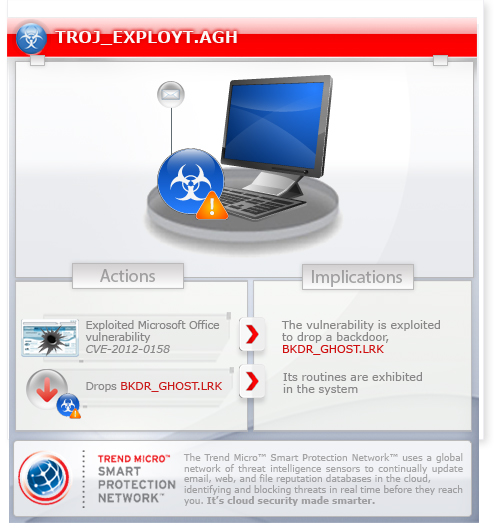TROJ_EXPLOYT.AGH
Exp/20120158-A (Sophos) , MSOffice/CVE20120158.fam!exploit (Fortinet) ,Exploit:Win32/Shellcode.AB (Microsoft) ,Exploit.MSWord.CVE-2012-0158.ab (v) (Sunbelt)
Windows 2000, Windows Server 2003, Windows XP (32-bit, 64-bit), Windows Vista (32-bit, 64-bit), Windows 7 (32-bit, 64-bit)


Threat Type: Trojan
Destructiveness: No
Encrypted: Yes
In the wild: Yes
OVERVIEW
This malicious .DOC file entitled "Violent terror attack" took advantage of the mass stabbing incident in Kunming, China in early March 2014, as social engineering bait. It exploited Microsoft Office vulnerability CVE-2012-0158 to drop a backdoor, BKDR_GHOST.LRK.
To get a one-glance comprehensive view of the behavior of this Trojan, refer to the Threat Diagram shown below.

This Trojan arrives as attachment to mass-mailed email messages.
It executes the dropped file(s). As a result, malicious routines of the dropped files are exhibited on the affected system.
It takes advantage of certain vulnerabilities.
TECHNICAL DETAILS
Arrival Details
This Trojan arrives as attachment to mass-mailed email messages.
Dropping Routine
This Trojan drops the following files:
- %User Temp%\aa.doc - decoy document file
- %User Temp%\DW20.exe - detected as BKDR_GHOST.LRK
(Note: %User Temp% is the current user's Temp folder, which is usually C:\Documents and Settings\{user name}\Local Settings\Temp on Windows 2000, XP, and Server 2003, or C:\Users\{user name}\AppData\Local\Temp on Windows Vista, 7, and 8.)
It executes the dropped file. As a result, malicious routines of the dropped file are exhibited on the affected system.
Other Details
This Trojan takes advantage of the following vulnerabilities:
SOLUTION
Step 1
Before doing any scans, Windows 7, Windows 8, Windows 8.1, and Windows 10 users must disable System Restore to allow full scanning of their computers.
Step 2
Remove the malware/grayware file dropped/downloaded by TROJ_EXPLOYT.AGH. (Note: Please skip this step if the threat(s) listed below have already been removed.)
Step 3
Search and delete these files
- %User Temp%\aa.doc
Step 4
Scan your computer with your Trend Micro product to delete files detected as TROJ_EXPLOYT.AGH If the detected files have already been cleaned, deleted, or quarantined by your Trend Micro product, no further step is required. You may opt to simply delete the quarantined files. Please check the following Trend Micro Support pages for more information:
Step 5
Download and apply this security patch Refrain from using these products until the appropriate patches have been installed. Trend Micro advises users to download critical patches upon release by vendors.
Did this description help? Tell us how we did.


